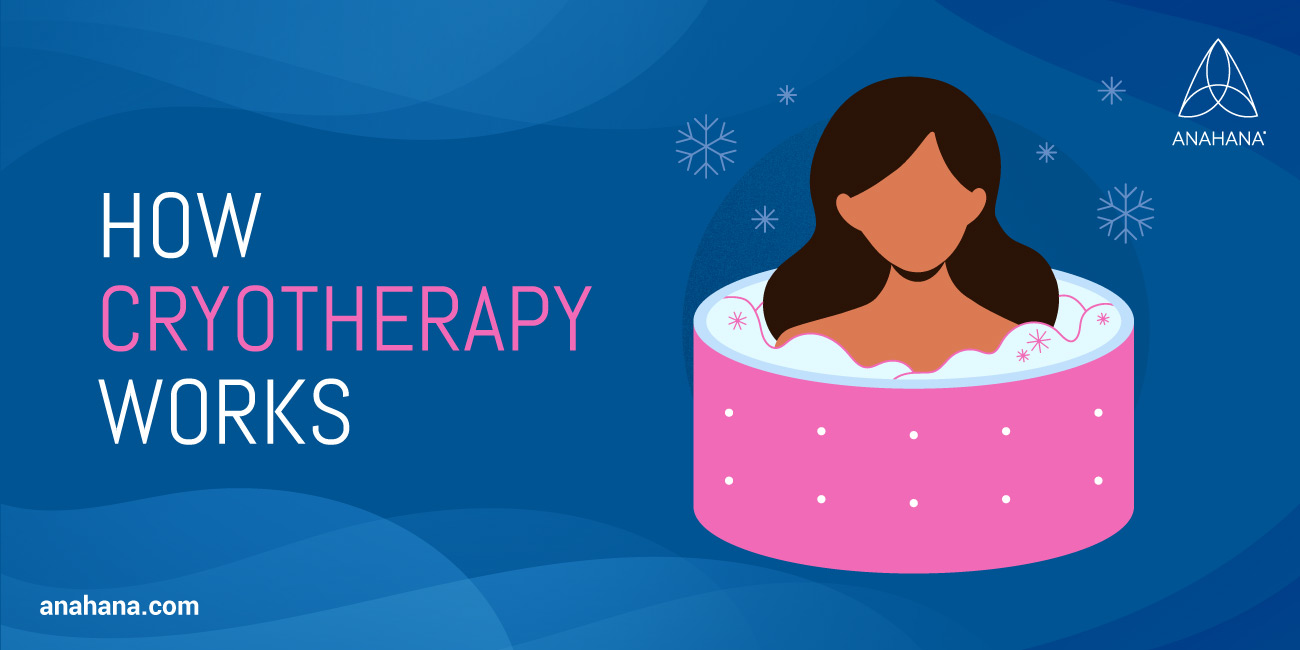
Table of Contents
Cryotherapy is a treatment that can help with stress, anxiety, pain, and injury rehabilitation. Cryotherapy is performed by exposing the body or skin to cold temperatures. One may receive cryotherapy treatments in a clinic, med spa, or at home.
Definition of Cryotherapy
 Cryotherapy, or cold therapy, is a medical treatment that involves exposing the body to cold temperatures. Cryotherapy helps treat many medical conditions, including muscle pain, skin conditions, sports injuries, rheumatoid arthritis, and cancer. Cryotherapy has also shown positive effects on treating the symptoms of some mental conditions, including; stress and anxiety disorders. Many more benefits, from immune system improvements to weight loss, have some anecdotal evidence to support the treatment.
Cryotherapy, or cold therapy, is a medical treatment that involves exposing the body to cold temperatures. Cryotherapy helps treat many medical conditions, including muscle pain, skin conditions, sports injuries, rheumatoid arthritis, and cancer. Cryotherapy has also shown positive effects on treating the symptoms of some mental conditions, including; stress and anxiety disorders. Many more benefits, from immune system improvements to weight loss, have some anecdotal evidence to support the treatment.
Applications and Benefits of Cryotherapy
As an emerging medical treatment, there is still ongoing research on the many uses of cryotherapy. Many benefits have already been proven, but further trials are needed to understand the full scope of cryotherapy’s potential benefits.
Reducing Inflammation and Pain Relief
Ice packs and baths are the most basic form of cryotherapy and have been used to treat stiff muscles for centuries. Ice baths or the application of an ice pack is known to reduce inflammation and swelling in muscles and connective tissue; whole-body cryotherapy takes this concept to an extreme, using temperatures as low as -300° F to achieve the same results. Patients often report less pain and reduced swelling following cryotherapy treatments.
Cancer Treatment
Cryotherapy for cancer treatment, called cryoablation, is an adjunct treatment for several forms of cancer, including bone, skin, liver, lung, prostate, and breast cancer. The process involves inserting a thin needle directly into the affected area and pumping liquid nitrous oxide or argon gas to destroy abnormal tissue and kill cancer cells. Medical literature from the American National Cancer Institute recognizes cryoablation as a treatment for cancer but advises that there is room for more research on its effectiveness in long-term cancer remediation. Cryotherapy can also be used to treat benign (non-cancerous) tumors.
Chronic Pain and Disease Treatment
Swelling and inflammation in muscle and connective tissue is a common cause of chronic pain, athletic injuries, rheumatoid arthritis, and disease. Cryotherapy for chronic pain involves exposing the affected area or the whole body to extremely low temperatures, reducing inflammation and blood flow. Following the removal of the cold stimulus, blood circulation increases, bringing nutrient and oxygen-rich blood to the injured or diseased tissue, promoting healing. In the case of multiple sclerosis, the application of cold reduces muscle spasms and their associated pain.
Injury Rehabilitation
Due to its powerful anti-inflammatory properties, cryotherapy may have a positive effect during rehabilitation. Applying ice to inflamed or sore body parts following physical therapy or stretching is often recommended to reduce swelling and pain. Applying cold therapy does not necessarily treat injuries independently but may be beneficially incorporated into the treatment plan. Some evidence suggests that swelling improves the healing rate over time, so allowing some natural swelling may benefit the healing process.
Athletic Performance
Some athletes regularly use cryotherapy after intense exercise. The surge of nutrient-rich blood rushing to muscles following whole-body cryotherapy is beneficial to prevent muscle soreness.
Skin Treatment
Cryotherapy is used as a treatment for some skin conditions. Cryotherapy can remedy warts, skin lesions, skin tags, atopic dermatitis, keratosis, and more skin conditions by applying extreme cold to drop the skin temperature low enough to kill or remove abnormal tissue. Coolant sprays for this purpose are sold worldwide and are generally available without a prescription.
Stress, Anxiety, and Mental Health
Cold treatments have a profound effect on neurochemical release. Following whole-body cryotherapy, some patients suffering from clinically-diagnosed depression reported over a 50% reduction in depressive symptoms. It is thought that whole-body cryotherapy causes a surge of dopamine and adrenaline, improving mood and reducing depressive symptoms. These effects require further research, but the results are promising.
The proposed strategy for treating mental health conditions with cryotherapy involves its use alongside current, proven medical interventions. Research studies looking at the effects of cryotherapy treatment on mental health conditions are pretty new, and the topic certainly demands more study. Still, the current anecdotal evidence is very promising for the future treatment of mental conditions.
How Cryotherapy Works
 All forms of cryotherapy rely on the same concept; exposing the body to cold temperatures. Cold water immersion, ice massage, ice pack application, cold chambers, ice baths, and cooling sprays all work by dropping skin temperature to a low enough level to cause changes in the tissues and chemical receptors below. More specialized forms of cryotherapy, like cryoablation, can use subdermal applications of cold under the skin in mildly invasive surgery procedures. In all cases, cryotherapy lowers the temperature of cells and tissues to cause changes in those tissues.
All forms of cryotherapy rely on the same concept; exposing the body to cold temperatures. Cold water immersion, ice massage, ice pack application, cold chambers, ice baths, and cooling sprays all work by dropping skin temperature to a low enough level to cause changes in the tissues and chemical receptors below. More specialized forms of cryotherapy, like cryoablation, can use subdermal applications of cold under the skin in mildly invasive surgery procedures. In all cases, cryotherapy lowers the temperature of cells and tissues to cause changes in those tissues.
Physiology of Cryotherapy
Very low temperatures cause notable changes in the entire body. Nerve conduction velocities, blood flow, pain perception, and hormone release are all impacted by cryotherapy in local and systemic ways. Because of its varied effects, cryotherapy is used differently depending on what condition it is treating.
Cryotherapy Methods and Devices
Several methods of cold therapy exist, including ice packs, liquid nitrogen, coolant sprays, an ice bath, or a cryotherapy chamber. These all have the same end goal: to expose the target tissue to subzero temperatures and induce healing.
Whole-Body Cryotherapy
Whole-body cryotherapy is offered at some med spas and sports medicine clinics and involves specialized cold chambers for these treatments. Patients stand inside the chamber for up to 3 minutes while liquid nitrous oxide is pumped in, reducing the body's temperature. Whole-body cryotherapy is thought to improve sleep and increase metabolism for weight loss, as well as the well-known pain and inflammation reduction benefits. Patients often report feeling refreshed and invigorated following treatments.
Internal and External Cryotherapy
Cryotherapy can be applied outside the body, either directly through cold items contacting the skin or by convection, such as when cold gas is used, like in a cryotherapy chamber. External cryotherapy is the most common form of cryotherapy. Internal cryotherapy, or cryoablation, is most commonly used to treat cancers and for the occlusion of veins in certain cardiac procedures. An instrument called a cryoprobe inserts into the area and pumps in liquid nitrogen, rapidly cooling the targeted tissues.
Clinical Settings
Cryoprobes and cold chambers are most commonly used in clinical settings, as these tools require specific training and professional application. A doctor or other healthcare provider should perform any procedure involving injections. Due to the risks associated with this treatment, a professional should always be present for whole-body cryotherapy. Clinical cryotherapy is a relatively new phenomenon but is now available in clinics worldwide.
Cryotherapy at Home
Cryotherapy is not a complex process and is easy to apply at home. Ice packs, cold water immersion, or an ice bath are easily applied in-home and carry few risks compared to the extreme cold used in clinical cryotherapy. Still, getting clearance from a healthcare provider before beginning any at-home cryotherapy protocol is essential.
Safety Considerations
Cryotherapy involves very cold temperatures, so patients must take caution to avoid injury. Speak to a doctor before attempting any kind of cryotherapy, and always exercise caution when working with extreme cold. Most positive reports for the benefits of cryotherapy are anecdotal, meaning that benefits have been reported, but further studies are needed to ensure its efficacy.
Frequently Asked Questions
Is Cryotherapy Safe?
Cryotherapy poses risks due to its use at very low temperatures, but the likelihood of injury is low under professional guidance.
Does Whole-Body Cryotherapy Hurt?
Most patients report discomfort rather than pain. Due to cryotherapy being a “dry cold,” it doesn’t sting like cold water or ice packs.
Why Doesn’t Cryotherapy Cause Frostbite or Hypothermia?
In short - it can. There have been reports of injury from cryotherapy, but these are rare. In the case of whole-body cryotherapy, the gasses do not wick away heat as fast as water or other fluid directly contacting the body. These gasses reduce the likelihood of frostbite or hypothermia, but it is still possible.
How Long Has Cryotherapy Been Around?
Using cold to treat bodily conditions has been reported as far back as ancient times, but whole-body cryotherapy is much newer. Originating in Japan in the 1970s, whole-body cryotherapy as we know it today has been around for over 50 years.
References
Whole Body Cryotherapy Induced Reversible Cerebral Vasoconstriction Syndrome (P3.118) | Neurology
Cryosurgery for common skin conditions
Cryoablation for cancer - Mayo Clinic
Definition of cryoablation - NCI Dictionary of Cancer Terms
Cryosurgery to Treat Cancer - NCI
The cold truth: the role of cryotherapy in the treatment of injury and recovery from exercise
Whole-body cryotherapy as adjunct treatment of depressive and anxiety disorders - PMC

By: Anahana
The Anahana team of researchers, writers, topic experts, and computer scientists come together worldwide to create educational and practical wellbeing articles, courses, and technology. Experienced professionals in mental and physical health, meditation, yoga, pilates, and many other fields collaborate to make complex topics easy to understand.
